1. Mulch and mulching - the natural
parasol for the ground
What falls down in the forest becomes mulch - mulching
in the garden is imitating the forest
Mulching is the process that occurs in the forest when
foliage, grasses, mosses and dying or dead plants or holes
cover the soil. The soil is protected from the sun (acts
like a parasol [web22]) and the soil receives new
nutrients by the degradation of the materials. The soil
population is growing, the soil remains loose and
permeable [web06]. Mulching is an imitation of the fall of
leaves in the forest [web22].
Mulching is a step in the serial mix culture and
permaculture. Mulching comes from Middle High German "mul"
= decaying earth, dust. Floor surfaces are covered with
organic materials (mulch). Sometimes the mulch has to be
reduced in size, then mulching tools are used to reduce
size, ie mulchers, sickle mulchers or flail mulchers
[web01].
Mulching takes place from spring to autumn. Before the
first mulching one should remove remaining weeds from the
planting bed [web06].
The effects of mulching in detail:
 |
Mulching, scheme
with nutrients, condensation and without weeds
and without pesticides [15]
Permaculture agriculture with mulch WITHOUT
pesticides, WITHOUT contamination, almost
WITHOUT weeding, WITHOUT digging, and
practically WITHOUT giving water (!)
Permaculture with mulch, WITHOUT
pesticides
-- Mulch is organically reduced, nutrients
enrich the soil
-- Sunlight is reflected, under the mulch
comes condensation, the earth remains
moist
- Without sun weed seeds have no chance and do
not germinate or hardly - pesticides are NOT
needed (!)
- Mulch protects the roots from temperature
fluctuations. The plant with mulch grows better
- NO contamination, almost NO weeding, NO
digging, practically NO giving water is
necessary
Industrial agriculture without mulch, with
pesticides
-- The heat makes any moisture evaporate, the
soil dries out, nutrients do not come
-- a lot of weeds are growing, provoking the use
of pesticides
- Erosion: Rain and wind can erode the
unprotected soil - fertilizers + pesticides go
into the groundwater and pollute the groundwater
(!)
-- MUCH contamination, MUCH weeding, MUCH
digging, MUCH giving water are necessary - which
provoked the destruction of the soil, of ground
water, and high costs!
|
1.
Mulching has a great protective function:
the soil is protected from the sun, stays cool for longer,
and in the evening the soil stays warm longer. This
lengthens the vegetation period, reduces moisture loss,
heavy rainfall causes slurry and prevents the soil from
being washed out, there is no wind erosion [web01].
2.
Mulching (except bark mulch) causes nutrient
input with nitrogen, because the mulch layer
is gradually decomposed (composting) and it creates new
humus like an organic fertilizer. The decomposition
process produces a lot of nitrogen (N), which promotes
plant growth: "When at the end the micro-organisms die
off, they themselves become a source of nitrogen." The
bound nitrogen is released in the long term with the
decomposition of organic matter. " [web01]
Soil animals (earthworms, etc.) also pull the mulch
material into deeper soil layers, earthworms eat it, and
their excrements are the best humus, as in composting with
compost heaps - the precondition is a balanced ratio
between carbon (C) and nitrogen (N) [web01].
3.
The mulching promotes soil life, the
soil population [web06] [and the microorganisms] are
larger than without mulching and this saves at least one
process with artificial fertilizer [web06].
4.
Mulching is fighting weeds: Mulch keeps
the soil in the shade so that weeds have little chance to
grow. But sometimes it can not be completely prevented
[web01]. When weeds come up, then they are only loose in
the soil without large roots thus taking them out from the
loose and fostered soil is no problem [web06]. When straw
is laid out, the straw mulch prevents weeds from growing
on the paths [web05].
5. Mulching for the ground
-- "Mulching is a very effective way to improve soil
quality" [web06]
-- Mulch loosens the soil and supplies it with nutrients,
depending on the material [web06]
-- This benefits both the soil and the plants [web06]
-- Weeds can be limited, and the soil is loose, therefore
it is easy to remove the weeds when there are any left
[web06]
-- The processing of mulch on the planting bed needs
nitrogen [web20], especially the wood mulch (bark mulch,
sawdust etc.) [web01]. To compensate for the lack of
nitrogen, one can distribute some compost or some manure
on the mulch. At the same time, the plants AND the
bacteria are supplied with nitrogen, and the bacteria
degrade the mull even better. Chicken manure can be placed
fresh on the mulch cover without prior composting [web20]
-- One must not mix the mulch with the soil layer,
otherwise the bacteria extract more nitrogen from the soil
[web20]
6. Mulching against erosion
-- Furthermore, mulching protects against nutrient
elimination by heavy rain and is a protection from erosion
by heavy rain [web06]
-- Stifling of heavy soils is hampered [web06]
-- One can mulch lawns, flower beds, vegetable beds and
herb beds as well as bushes and shrubs [web06]
-- But not every kind of mulch is suitable for every plant
[web06]
-- When there is naked earth left, unwanted seeds can
germinate - but checking regularly and covering also all
naked spots, one can easily pick these plants out [web06]
7.
Fallow time with mulching:
-- Mulching can improve the soil during a fallow period
and hinder the bushes and brushes becoming dominate
[web01].
Warning: NEVER mulch rough pastures - but create new
rough pastures

Rough meadow (poor grassland) with many flowers [19]
-- Rough meadows (poor grassland, alkaline grassland,
flower meadows) should NEVER be mulched, otherwise they
will not remain a rough meadow [web01] [but become a fat
pasture meadow without flowers].
-- Mulching with bark mulch or wood shavings or chaff
material removes a lot of nitrogen (N) from the soil
[web01] and provokes new rough meadows (flower meadows)
[Conclusion Palomino].
And: mulching [if it's a garden patch with earthworms and
with a healthy soil population]
-- saves digging [web07],
-- saves weeding [web08], and
-- saves giving water [web09].
Never mulch on poor meadows - otherwise the
Magerwiese is no longer "poor" (!): When rough
grasslands with flowers or embankments, stream banks and
strips of road meadows are mulched too much, the nitrogen
content increases so much that wild plants and flowers of
rough meadowsn avoid the areas [and almost only grass is
growing]. The mulch also hinders the lives of insects,
butterfly caterpillars, snails, small animals such as
frogs, snakes, lizards, soil breeder birds. [web01]
Books about mulching -
Link
Summary: The benefits of mulching
-- "A mulch layer keeps the moisture in the soil and
protects against dehydration.
-- Less water has to be given, less weeded and less
fertilized.
-- Mulch protects and promotes microorganisms and other
living things in the soil.
-- Thus, it also promotes the formation of humus.
-- Weed growth is suppressed.
-- Isolated weeds are very easy to remove.
-- The soil remains loose, so less has to be chopped.
-- A mulch layer protects against all weather conditions.
-- Heavy soils do not become silty so fast.
-- Furthermore, it [the mulch layer] protects against the
elimination of nutrients by erosion.
-- Flowers bloom magnificently and yields concerning
fruits and vegetables are improved.
-- In winter, a layer of mulch protects against heavy
frosts and in summer from the heat [web06].
NEVER mulch on nutrient-poor meadows, otherwise the poor
meadow will soon no longer be a poor meadows and all
flowers go away.
2. Mulching principles
-- Mulch is distributed ON the soil and is NOT
incorporated into the soil [web06], this work are
performing the ground animals (earth worms etc.) [web01]
-- Mulch is biological material, but should be WITHOUT
seeds so there will not grow unwanted plants [web01]
-- There is organic mulch material but there are also some
different mulch films [web06].
The first mulching in spring
Das erste Mulchen im Frühling

Mulch with rake [20]
-- For the first sowing in the spring you have to pull the
mulch with the rake a few days before to the side, then
comes the sowing action or seedlings are planted, and now
one has to wait until the plants grow a few inches tall.
Only now the mulch can be planted around the plants
[web20]
-- In spring a few days before the first sowing you have
to pull the mulch layer aside so that the sun can warm the
ground [web20]
-- In spring, the soil should be thoroughly loosened
[web20]
-- After sowing or planting seedlings, one should wait
with the mulch until the plants are 10cm tall, otherwise
the mulch hinders growth [web06, web20]
-- Sowing goes with the Maria Thun Calendar. The
advantages of a thick layer of mulch are unbeatable
[web20].
Mulching in summer and autumn
-- In summer one can mulch so that the soil is properly
shady and cool and will not dry out [web06]
-- In autumn, the mulch delays the cooling of the soil on
cold nights and prolongs the growing season [web06]
-- Sowing in the mulch has no sense, nothing germinates
[web20].
The thickness of the mulch layer: 10 to 15cm - sand
+ sawdust + grass clippings maximum 5cm
-- With straw mulch, the mulch layer must be at least 10
to 15cm thick, so that the soil remains moist and weeds
can not grow [web20]
-- With sand or sawdust as mulch, the layer is about 5cm
thick [web29]
-- A grass clippings mulch must not be over 5cm thick,
otherwise it will rot and be slimy. To prevent rotten or
slimy mulch, grass clippings can be mixed in the ratio 1:1
with wood chips or other coarse, brown materials. The wood
chips then absorb the moisture [web20]
-- The mulch layer in the grass clippings should never be
applied thicker than 5 cm, otherwise come worms and voles;
it is better to mimic something if necessary, than to risk
snails, voles or rot - only with straw mulch you can mulch
without problems thicker [web06]
-- Only when the plants have reached 10cm in size, one can
put the mulch, not before, the principle is always
that mulch must not hinders the growth [web06]
-- A too thick layer could lead to rot and attract snails
[web06]
-- Less mulching and often mulching is better than to put
too much of it [web06]
-- Mulch should not be worked into the soil, except mature
compost [which is fresh earth].
-- There is no fixed time for mulching, but the plants
should be larger than 10 cm. [web06]
-- When there are forming bald spots in the bed, one has
to repeat mulching there [web06].
Mulching on loamy soils
-- When there is gardening on heavy, clayey and clayey
soil, the soil must dry off a bit after winter [mulch]
[web06] - [so the first mulching will be a little bit
later].
3. The mulch material
Generally: Mulch should always be in stock to be prepared
for drought [web02]. Mulch can be stored in garbage bags,
with a few air holes in the garbage bags [web02]. Mulch on
garden beds can be: leaves, nettle leaves (WITHOUT seeds),
deciduous mulch (WITHOUT leaf diseases), grassy mulch
(little dried, NOT moist), weeds (WITHOUT seeds), straw
(WITHOUT pesticides), hackled branches, bark mulch,
bedding mulch from stables.
Or there can also be a planting with a green manure with
plants tearing up much nitrogene to the surface:
buckwheat, pea, summer pea [web05].
The mulch materials are:
Leaf mulch and deciduous mulch
--
Leaf mulch of vegetables
-- leaves that are left from harvests (for example,
cabbage leaves or potato leaves), should not be thrown
away, but rather mulch other vegetable crops with it
[web05]
-- the leaves must be healthy and must not be infested
with pests [web05].
-- leaf mulch with tree leaves [web23]

Green mulch on a dam bed with
tree leaves [12]
--
mulch of stinging nettle + comfrey
[web05] [stinging nettle leaves WITHOUT seeds]
 Stinging nettle [7]
Stinging nettle [7]
-- "Leaves mulch composed of comfrey leaves and
stinging nettle leaves" [web06]
-- "The leaves of comfrey and stinging nettle
release more nitrogen and potassium into the
soil during decomposition, and the stinging
nettle also releases silicon, which is good for
tomatoes, for example, which makes the leaves
mulch in addition to a wholesome fertilizer to
be mulled more often, as the leaves decompose
relatively quickly." [web06]
-- with cucumbers, tomatoes or beans: "Dried
stinging nettles and comfrey leaves are great
for cucumbers, tomatoes or beans, they protect
the soil and enrich it with valuable minerals
during decomposition, but because they rot very
quickly you often have to mulch again. The layer
can be up to 10cm." [web05]
-- Leaves mulch

Autumn leaves [6]
-- The leaves for foliage mulch can be obtained in the
forest, or from trees in the park [web02]
-- But not every foliage is suitable: leaves of chestnuts,
oaks and walnut trees are unsuitable [web06]
-- Foliage mulch is of autumn leaves [web02] - foliage
contains carbon [web01] and moisturizes [web19]
-- Fall foliage on the ground stores moisture, suppresses
weed growth, and nutrients get back into the ground [by
earthworms and other soil animals] [web02]
-- The foliage (tree leaves) should first be reduced in
size before being laid up as a mulch [because this is the
first step of decomposition], e.g. one can drive over the
laid leaves with a hand lawnmower, and then the cut leaves
are placed around the plants [web02].
-- Foliage mulch can be placed on the planting beds of
strawberries, near fruit trees, near berry bushes, one can
also cover flower bulbs with it [web06]
Attention: leaves from parks in urban areas may contain
heavy metals of traffic and industrial enterprises and
this foliage CANNOT be used but has to be burnt [web01].
Grass mulch

+

Grass clippings, green cuttings, lawn mulch [18] -
planting bed with bark mulch [2]
--
Grassy mulch: green cuttings / grass clippings /
lawn clippings / cut mulch
-- Grass clippings can be provided from every lawn [web02]
-- Grass clippings provide nitrogen (N) and nutrients
[web19]
-- Grass clippings contain nitrogen, please note: moist
green cutting may rot [web01]
-- The lawn clippings should be allowed to dry a bit
[web05], must always be dry or "wilted" [web06], and then
apply a thin layer, otherwise there is a risk of humid
rotting [web05]
-- Grass clippings can be mixed with wood shavings, the
wood chips absorb the moisture so that no humid rot will
occur [web20]
-- Grass clippings can be applied to all plants [web05]
-- Lawn clippings are a good nitrogen and potassium
enrichment [web05]
-- Grass clippings are put around water hungry plants
[e.g. tomatoes] [web02].
-- "Grass clippings with seed pods should not be used as
mulch" [web06]
--
mulch a lawn
-- who wants to mulch the lawn, mows in the spring during
dry weather and mulch the lawn with the grass clippings
[web06]
-- or mow with a mulching lawnmower that immediately
shreds and disperses the clippings [web06]
-- The lawn becomes fresher, more vital with these
additional nutrients, becomes denser with a rich green
color [web06].
Mulching with grass clippings
-- Mix grass clippings with wood chaff to guarantee a
better ventilation, so that there will be NO humid rot for
sure [web05]
--
Grass mulch: Miscanthus chaff (crushed
miscanthus): this is a grass, hard and
sharp-edged, this mulch is suitable for all plants and as
a road-railing. Snails and weeds avoid the hard,
sharp-edged stalk chips. Apply 3 to 5 cm thick [web05].
[Supplement: Miscanthus is dangerous for
bare feet - slugs are eliminated by certain
flies+ducks
When there is miscanthus from China, one cannot walk
barefoot any more or cuts will be hard to suffer. Slugs
can be "eliminated" with some specialized flies, with
ducks etc.].
Plant mulch (green manure)
Certain plants can also be used as green manure:
-- "Buckwheat, veal and summer pea can be used
well as a mulch for a variety of vegetables, as
many green manure plants are rich in nutrients.
And they also enrich the soil with valuable
humus.Let the freshly cut green manure plants
dry slightly before mulching them so they will
not rot. As plants are normally reduced fast one
has to remulch from time to time." [web05]
-- Weeds as mulch: [web03] -
Weeds and plant remains must be known exactly so
that unwanted seeds are not spread [web01].
Straw mulch
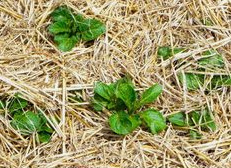

Planting bed with straw mulch
[1] - straw bales for straw mulch [16]
-- Straw: straw mulch contains carbon
[web01].
-- With straw mulch you can mulch without problems
thicker than 5cm [web06], so 10 to 15cm [web20]
-- Straw mulch can be put also on the paths in the
vegetable garden and on the garden beds with
strawberries, sweetcorn, cucumbers, zucchini, tomatoes
[web05]
-- Straw mulch promotes aeration, at the same time
fixes the nitrogen in the soil, good nutrient
procedure before straw mulching is important [web05]
[this means: on a "dead" soil straw mulch does not
work]
-- Straw mulch on strawberry fields reduces
snail-eating and gray-mold [web05]
-- One has to know precisely where the straw is coming
from: Straw from pesticide farms may contain
pesticides [web01], e.g. when chemicals have been used
on cereal fields for the stability of the blades in
the wind and against rain damage [web05].
Chaff mulch, wodden chaff
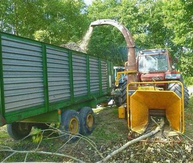
Chaffcutter machine (a wood shredder) "eats" thin branches
and the chaffed material comes directly onto the trailer
[21]
--
Chaffed mulch (cut branches cut in a
chaffcutter):
-- Chaffed material or chaffed mulch can be: cut branches
of cut trees, or even cut pine branches [web05].
-- Wood chaffs are very poor in nitrogen [web05] and
during the decomposition process a lot of nitrogen is
removed from the soil and slows down plant growth [web06]
-- if wood chippings are used as mulch, one should first
use horn shavings to balance the nitrogen consumption of
the wooden chaffs [web05]
-- principally wooden chaffs as a mulch are only usable
under strong trees or hedges [web06]
Comparison of mulch: sand - sawdust -
straw pellets: sawdust is the best mulch
The experiment was done in Ireland on a heavy, loamy soil
with a garlic bed. On one strip was put sand, on another
sawdust [the German video always gives false indication of
"wood shavings"], another strip is with straw pellets, and
a control strip was left without mulch. There was almost
no weed in the mulch areas. In the area of sawdust mulch
the garlic bulbs grew the largest [web29].
Video: Gardening without digging -
three different varieties of garden mulch in
comparison (8'14'')
(original German: Gärtnern ohne umzugraben - drei
verschiedene Varianten von Gartenmulch im Vergleich)
Here is the video Protocol:
Planting garlic is said to drive out weeds, which is tried
out here (1'5 ''). The garlic cloves are placed and then
mulched with normal sand (1'28 ''). Sand slightly loosens
up the ground (1'34 ''). With loamy soil, sand as a mulch
is a good choice (1'40 ''). In another area is mulched
with sawdust (1'55 ''). Sawdust is said to pull a lot of
nitrogen out of the ground and slow down growth, let's see
what it looks like in the long run (2'14 ''). In the last
area, straw is laid out in the form of pellets (2'23 '').
The straw pellets then absorb a lot of water and will
swell slightly (2'48 ''). Sawdust and straw pellets are
decomposed and add nutrients to the soil (3'16 ''). As
control there is a small fourth sector without any mulch
(3'27 ''). [web29]

Mulching in Ireland in the garlic field: sand, sawdust
and straw pellets plus a control field without mulch
[36]
After a few weeks, the garlic sprouts through the mulch,
and hardly any weeds (3'43 ''). All garlic cloves sprout
(3'56 ''). There was no difference between the beds (4'3
''). It does not take weed control (4'13 ''). If there was
some weeds, it was easy to remove (4'26 ''). In early
August, the harvest came with big garlic bulbs (5'9 '').
When flowers bloom beside it, the tuber only grows small
(6'11 ''). Where weeds have grown, the tubers are small
(7'0 ''). In the bed with sawdust mulch grew the largest
garlic bulbs (7'22 ''). Some garlic bulbs were up to 1 /
2kg heavy there (7'26 ''). In the non-mulched comparative
bed, the garlic bulbs weighed over 50% less (7'37 '').
Without mulch 200g of weight, with straw mulch and sand up
to 450g heavy, and with sawdust mulch up to 500g of weight
(7'48 ''). The tubers are really partly giants (8'2 '').
[web29]
Ireland, the garlic harvest in early
August, some of the tubers are gigantic - The
statistics: in sawdust as a mulch are garlic bulbs up to
500g heavy, with sand and straw pellets up to 450g, and
in the control field without mulch only up to 200g heavy
- Giant garlic bulb opened [37-42]
Fir branches as mulch
-- Fir branch mulch is suitable for acid-loving plants:
blueberries, strawberries, garlic and potatoes [web19]
-- cut fir branches are also possible as a mulch [web05]
Bark mulch (chopped bark as mulch)

Planting bed
with bark mulch [2]
Bark mulch is suitable for paths to prevent weeds and
generally improve the soil [web05].
Shredded wood, pieces of bark or sawdust store moisture
and keep the soil cool [web19].
--
Bark mulch [barked tree bark] contains
carbon (C), needs nitrogen replacement fertilization
before laying, because the soil animals need the nitrogen
(N) in the soil for the decomposition of the bark mulch
and the plants then lack the nitrogen. Therefore
fertilizing with natural fertilizer BEFORE the application
of the bark mulch is necessary, e.g. for perennial
vegetables with horn shavings 50-80g / m2 [web01]
Bark mulch (also mixed conifer bark and deciduous bark)
can be put on paths, under trees, under shrubs. Healthy
bark mulch smells like resin. Digested bark moss has a
smell of methanol or sulfur (fecal odor). Rotted bark
mulch causes less growth or even death. Ventilation can be
done every few weeks, with raking [web05].
Bark mulch or wood chips are ideal for mulching dirt roads
and garden paths, because that's where nothing really
grows, but in the end the soil will be better than before
[web06].
--
Red bark mulch from pine bark (Pinus pinea):
this red bark pine tree comes from southern Europe, is
reddish, is a variation on paths ("red ways"), decomposes
slowly, does not smell as sour as Central European bark
mulch, is a nutrient supplier, improves soil structure and
inhibits germination of weeds - even in potted plants
[web05].

Paths
with red pine bark mulch [9]
--
wood shavings [from the carpentry]
contains a lot of carbon (C), needs a nitrogen composting
before laying, because the soil animals need the nitrogen
(N) in the soil (with perennial vegetables horn shavings
50-80g / m2) to decompose the wood shavings and the plants
then hardly have any nitrogen - takes a long time to
decompose [web01]
--
wood fibers as mulch [web06]
Industrial wood fiber mulch is "conserved" with chemicals,
is completely bullshit: "Wood fibers are made of spruce
wood and sometimes contain preservatives from the food
industry, which slows down the rotting process. It is
mixed with compost and bark humus." [web06]
--
Coniferous wood bark compost as mulch
Composted conifer bark is more compatible with many plants
because it does not bind as much nitrogen as fresh bark
mulch. The composted softwood bark can be used as a ground
cover as well as for soil loosening [web05]
Straw and sawdust as compensation for humid rot
When there is too much nitrogen in the soil, the soil
smells like liquid manure. As a balance one can mix straw
and wood shavings into it [web01].
Bedding mulch
Bedding in the barn can be of all possible things, but
above all of straw.
--
Bedding material from the duck house can
be used as a mulch [web03]
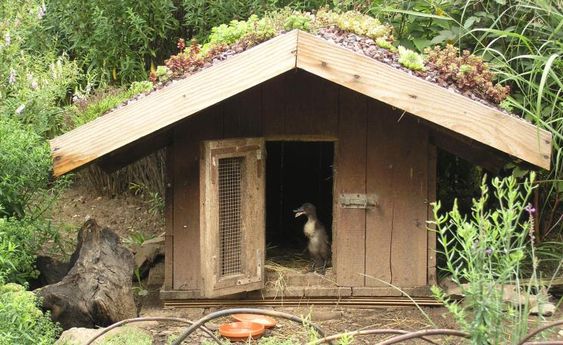

Duck house with straw bedding and duck [22] - Duck house
with barrels and straw bedding [23]
Compost mulch
Semi-mature compost as a mulch: "When
semi-mature compost is used, it should be covered with a
thin layer of grass to prevent dehydration. And
semi-mature compost should not be incorporated into the
soil, as opposed to fully matured compost." [web06 ]
Newsprint as a mulch additive
-- Newsprint keeps weeds down and stores moisture, thus
has a drying effect [web19].
4. Mulch films: mulch to roll out

Mulch film with holes on a garden bed [4]
"There are also different mulch films, mulch fleece or
mulch paper." [web06]
Mulch films (plastic)
Industrial mulch films are laid out on a fertilized bed
and protect the soil, but do not give off any nutrients.
Therefore, fertilization must be done beforehand. The laid
out mulch film is weighted at the edges with earth.
Crosses are slashed, the plants are put there and the
"flaps" are closed as well as possible. Sometimes the
mulch films also contain toxic substances [web06].
Mulch films (biodegradable)
Biodegradable mulch films are degradable and also deliver
nutrients, e.g. mulch films of corn starch [web06].
Mulch paper, mulch-fleece
Instead of mulching film one can also use mulch paper or
mulch fleece to avoid plastic waste [web06].
Remove the lawn putting cardboard for creating a new
plant bed


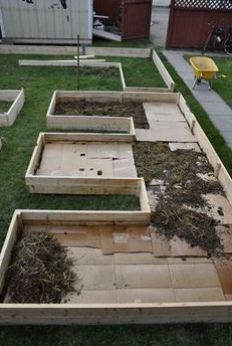
Putting cardboard on the lawn removes the lawn for
creating a garden patch [10,11] - for example one can
install garden beds in U form with cardboard [17]
With cardboard one can bring the lawn to a standstill and
create a new garden bed: Putting during few months the
cardboard on the lawn, without something on it, or even
with something on it, to enrich the soil even more. The
grass under the cardboard will decompose. In spring, the
lawn decomposes faster than in autumn [web23].
5. Every plant has its mulch
Which vegetables with which
mulch
-- All vegetables are working well with grass
cuttings and straw mulch [web06]. It can be
assumed that even with sand or sawdust all
plants grow well [conclusion from web29].
-- Nettle mulch goes with cucumbers, tomatoes or
beans [web05]
-- Allow grass clippings are everywhere
possible, but allow to dry slightly before and
apply only thin layers of it [web05], good for
water hungry plants [tomatoes] [web02]
-- Straw mulch is going well on planting beds
with strawberries, sweetcorn, cucumbers,
zucchini, tomatoes [web05]
-- Tomato mulching: with nettle
mulch, straw mulch [web05], grass clippings
[web02].

Mulched tomatoes with straw mulch [24]
Mulching cucumbers: with nettle mulch, straw
mulch [web05]
Mulching strawberries:
-- with straw mulch [web06] or with fir branch mulch -
strawberries are an acid-loving plant [web19]
-- after the harvest put a dry grass clippings mulch and
cover all [web06].

Homemade strawberries with straw
mulch [25]
Mulchin potatoes: with fir branch mulch -
potatoes are an acid-loving plant [web19]
Mulching garlic: with fir branch mulch -
garlic is an acid-loving plant [web19]
Mulching blueberries: with fir branch mulch
- Blueberries are an acid-loving plant [web19]
Mulching herb beds: with grass cut mulch or
straw mulch [web06].
Mulch warnings about vegetables
--
Bark mulch: "Bark mulch, for example, is
not suitable for freshly planted perennials, freshly
planted groundcover plants such as cotoneaster and plants
that prefer a calcareous soil, and some types of
vegetables are not suitable for mulching, such as: lamb's
lattuce, cabbage lettuce and chicory salad. Carrots, small
radishes, endives, radish, beetroot and onions. " [web06]
6. Mulch with shrubs and trees: keep
distance from then - the donut principle
Mulching shrubs
-- When there are new shrubs and bushes one can prepare
mulching after some weeks of growth: first sprinkle coarse
horn shavings, and then give 3 to 5cm bark compost as a
mulch over it, or long-fiber turf (peat), or shredded oak
leaves and walnut leaves. Weeds are restricted and the
soil remains moist. The horn shavings compensate for the
consumption of nitrogen. [web21]
Mulching trees: in the drip zone


Tree mulching in ring form (donut shape), in the drip zone
of the tree, never form a volcano form [13] - donuts [26]
-- "under trees and shrubs one can spread mulch from
woodchips" [web06]
-- when trees are mulched, this should take place in a
ring shape like a donut in the drip zone of the tree
[web18, web24]
Tree mulch
Best tree mulch: crushed hardwood mulch, organic mulch,
pallet shavings, red pine bark mulch, pinewood straw
[web24]
Less favorable tree mulch: grass clippings, peat moss,
sawdust, shredded rubber (rubber dust), stones, paving
stones or black plastic [web24].
Warning for mulching trees
-- Excessive mulching is charging the tree, and surface
roots grow into the mulch material [web24]
-- When the mulch touches the trunk, the tree bark softens
and organisms and insects in the mulch can penetrate the
soft bark tissue [web24] and damage the tree massively.
That's why the trees should be mulched always in the form
of a donut [conclusion Palomino].
Protection mulch against dogs and cats
![The protective ring for the tree with pine cones
and large pebbles [14]: This is usually sufficient to
confuse dogs and cats so that they no longer urinate on
the tree trunk The protective ring for the tree
with pine cones and large pebbles [14]: This is usually
sufficient to confuse dogs and cats so that they no
longer urinate on the tree trunk](../d/004a02-mulchen-d/014-baumschutz-kiefernzapfen+steinring-gg-hunde+katzen-urinieren.jpg)
The protective ring for the tree with pine cones and large
pebbles [14]: This is usually sufficient to confuse dogs
and cats so that they no longer urinate on the tree trunk
[web25].
7. Mulching seedlings
-- Cinnamon should protect seedlings from fungal
infestation and other infestations [web17]. But with
permaculture with mulch there should be NO fungal attack.
8. Stones as mulch
Stone layers as mulch: stone mulch for
planting beds - looks very gray and sad
"Gravel or grit
-- stores the heat of the sun well and long and are ideal
for the herb garden [herbs from the Mediterranean or from
Asia, which need the heat and love it]

Herb garden with
gravel [27]
-- Gravel or grit as a mulch keep weeds away for the most
part
-- Gravel or grit look "decorative" to some people
[although they are sterile and mostly gray only]
-- Gravel or grit do NOT provide nutrients [except when it
rains and when somebody is paving on the stones, minerals
are released by scrubbing]
-- The stones are at the same time a hindrance for working
with the soil (tilling) [web06]
-- [and the stone mulch gets extremely hot in the sun and
many plants are killed by the extrem heat].
Therefore: stone mulch is not recommended or really only
for Mediterranean plants which are planted in colder
climates.
9. Winter mulch - protection of the earth
from frost
Mulching for the winter in the garden: place cardboard
as mulch
In the late autumn, one can lay out a cardboard for the
wintering mulch on the garden bed, and NEVER put compost
as mulch for winter times, otherwise rodents will come,
nest there, eat away the compost, and also eat away tree
barks [web04].
10. The path mulch / stone layers for ways

Wood chips as path
mulch [28]
Paths can be laid out
-- with straw mulch [web05]
-- with bark mulch [web05]
-- with hard grass mulch, e.g. Chinese reed [web05] [but
then nobody can walk barefoot anymore]
-- with big gravel or little gravel, which release
minerals during rains, and when moving, when someone walks
over it or a vehicle drives over it, release minerals
powder into the ground [web01].
Anyone laying out paths with a stone covering or gravel
will enrich the ground steadily with the washed-out
minerals (in the rain) or with the minerals that have been
rubbed off [web06].
The indication that gravel roads have their value for a
nutrient-rich soil is lacking in natural history lessons
[Conclusion Palomino].
-- "Mulch is also suitable for attaching sitting areas and
walkways
-- On children's playgrounds it acts u.a. fall-damping
[bark mulch] [web06] - [for playgrounds I think the best
is artificial lawn]
-- After rain, it dries up relatively quickly." [web06]
Mulch at the playground: soft floor tiles or
artificial lawn
-- Playgrounds must have a soft bottom that dries quickly,
does not provoke dirty or damaged clothes, and where no
snails can hide: soft floor tiles or artificial lawn seems
the best in my eyes, because both types of soil dry
relatively quickly after a rain and snails can do not
hide:

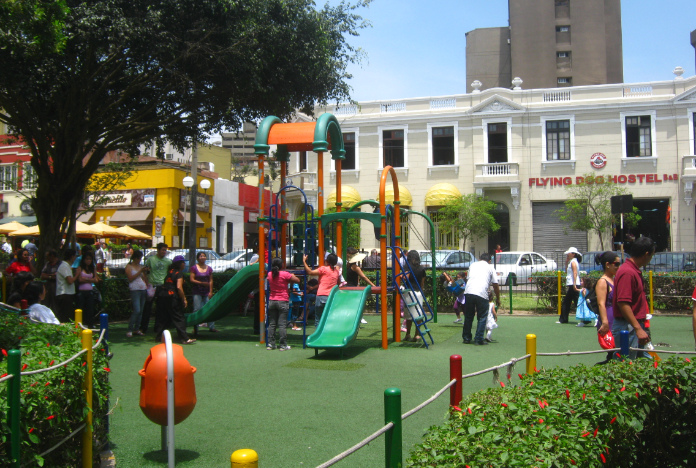
Playground with soft floor panels [30] - Playground with
artificial grass in the Parque Kennedy in Lima
(destroyed in 2015 by stupid Mayor Castañeda) [31]
Flower beds can be well mulched with grass clippings or
bark mulch [web06].
Rosary: Cut bark mixed with bark compost, or
garden compost ([when the compost has become good earth]:
mulching just to the rose bushes), or normal bark mulch
(leave space between the mulch and the rose bushes)
[web06].


Mulched rose in circle shape like a donut [32] - mulched
roses with bark mulch or woodchip mulch [33]
"When the roses are struck by blackspot [fungus:
Diplocarpon rosae] or rose rust [fungus: Phragmidium
mucronatum], be sure to completely collect and dispose of
any fallen leaves, and when you do not do so, the same
problems will occur next year as the pathogens overwinter
in the mulch." [web06]
12. Warnings for mulching: City leaves =
poisonous - loamy soil - poor meadows etc.
Tree leaves from the city park is unusable
City nurseries burn the tree foliage [web02] because they
probably know that this leaf from motorized cities is
heavily polluted and thus unusable [web05].
Where mulching has negative consequences
1.
Do not mulch on poor meadows - otherwise the
poor meadow will soon no longer be "poor" (!):
If on poor meadows with meadow flowers, or on embankments,
on creek banks and road strips is mulched too much, the
nitrogen content increases to such an extent that wild
plants and poor meadow flowers avoid the areas [and only
fat grass is growing]. The mulch also hinders the insects,
butterfly caterpillars, snails, small animals such as
frogs, snakes, lizards, soil breeder birds. [web01]
2.
Wrong mulching tactics
-- Too much mulch at once on the planting bed removes a
lot of nitrogen from the soil and then only little grows
[web06]
-- Too thick mulch layer can attract snails or voles
[web06]
-- Bark mulch or wood chips extract a lot of nitrogen from
the soil, it is necessary to put hornbeam chips before
laying out to compensate for this [web01]
-- "In regions where more harvest mites [
Neotrombicula
autumnalis] occur, the mulching should be completely
resigned because these tormentors feel relatively
comfortable in the moist mulch." [web06]
-- Industrial wood fiber mulch should be avoided because:
"Wood fibers are made from spruce wood and sometimes
contain preservatives from the food industry, which slows
down the rotting process. All is mixed with compost and
bark humus." [web06]
3.
Heavy loam soils: Mossad Wikipedia says:
Heavy, loamy soils are unfavorable for mulching because
these soils tend to stay cool even when the sun is shining
[web01].
But in Ireland, garlic was successfully harvested on heavy
clay soil with sand, straw pellets and sawdust mulch
[web29].
13. Slugs canNOT be stopped by mulching -
the list of animals that eat slugs


Snail snail shell on a branch [34] - A slug crosses a
stone path [35]
A snail or slug plague occurs only when the natural
enemies are missing [web27]:
| Table:
Animals that like to eat slugs or eat their
eggs |
Blackbird / Thrush
Silphids
Blindworm
Lizards
Magpie
Frogs
Hornflies (as parasites)
Hedgehog
Crow
Toads (especially common toads)
Larvae of fashion beetles
Ground beetles
Firefly larvae (fireflies) |
newts
mole
Crow
Salamander
Turtles
Snakes
Shrew
Stork
Centipede rob snail eggs
Tigerschnegel eat slugs
Daddy longlegs (snail cankers)
Burgundy snails eat the eggs of the slugs
|
|
web27 |
Ducks
|
web28
|
"So when it's possible to manage settling of more insects,
amphibians and birds in the garden, the snail plague will
be choked off (nipped in the bud)." [web27]
[Installing ponds and little lakes seems to be important -
all the ponds and little lakes which were eliminated since
1700 for winning more pasteland...]
There is no mulch against snails
-- There is NO mulch that helps against snails or slugs.
Especially in the rain, any protection is over [web11].
-- Snails and slugs: Hay and humid straw as mulch attracts
snails [web20].
But yes, there is mulch against snails:
Wood chips as mulch are rather avoided by snails and slugs
[web20]
AND:
Slugs avoid Chinese silver grass mulch
Miscanthus chaff (shredded miscanthus): is a grass, hard
and sharp-edged, is suitable for all plants and put on
paths. Snails, slugs and weeds avoid the hard, sharp-edged
stalk chips. Apply 3 to 5 cm thick [web30].
Well, who runs barefoot, will have cuts in the feet ...
Disadvantageous against snails
-- Mulch prevents slugs when the mulch is dry, but as soon
as it rains the protective effect is mostly over [web10]
-- D
ense, humid mull [wet grass clippings]
can attract snails (wet grass clippings) [web01]
--
a thick layer of mulch can attract
snails [web06]
-- "Gardens with increased snail and slug emergence should
only be mulched during prolonged periods of drought."
[web06]
--
Bark mulch, grass clippings and straw
are a paradise for snails, because they can hide well
under it and lay their eggs there [web10]
--
Crumbled eggshells have NO effect on
slugs, many snails and slugs hesitate at first, but then
pass the eggshell wall. Only the big snails [Burgundy
snail] are blocked [web11]
--
Sawdust becomes a snail's paradise when
it's raining, when they can hide under it [web11]
--
Primary rock meal is easily overcome by
all snails and slugs with rain [web11].
--
Coffee grounds (dried) are overcome even
during drought by the snails and slugs, sometimes
hesitantly, but then they pass [web12]
--
Mushroom lime slows down the snail
invasion, but does not prevent it [web13]
--
Scattering ashes prevents the little
snails, but the slugs have no problem with it [web14]
Unsuitable methods against snails when it's raining
--
untreated sheep wool spread on garden
beds acts against snails, as long as the sheep wool is
dry, so in the greenhouse this works [web11]
--
Scattering lime: carbonate sour lime or
magnesium lime counteracts snail eggs and the snail and
slug offspring, as long as the lime is dry - at the same
time the lime is corrosive and dangerous [web11]
--
Sprinkle salt: prevents snails and slugs
during dry weather, but when it rains the salt is flushed
into the soil and is salting the soil [web14]
--
Sprinkle diatomaceous earth has a deadly
effect above all against insects, but not against snails
or slugs which come again during the next rain when the
diatomaceous earth is swept into the ground [web15]
--
dried mint leaves are passed by snails
and slugs after a few attempts [web16]
What helps against snails is a snail collar:

Plastic in the garden looks very awkward: snail collar
against slug attack [5]
Better install shrubs and ponds for the snail and slug
enemies.







Mulch with rake [20]
Green mulch on a dam bed with tree leaves [12]
Stinging nettle [7]
Autumn leaves [6]
+


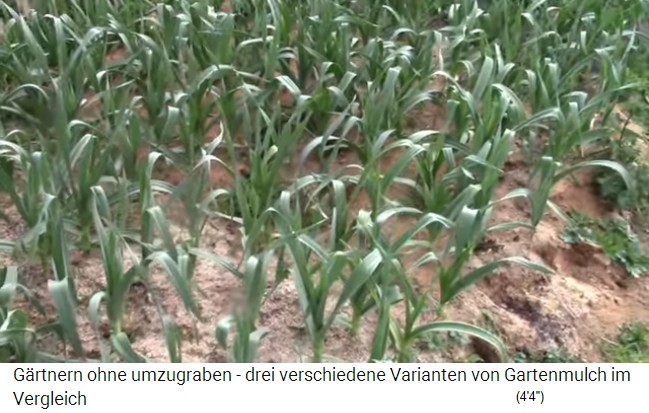
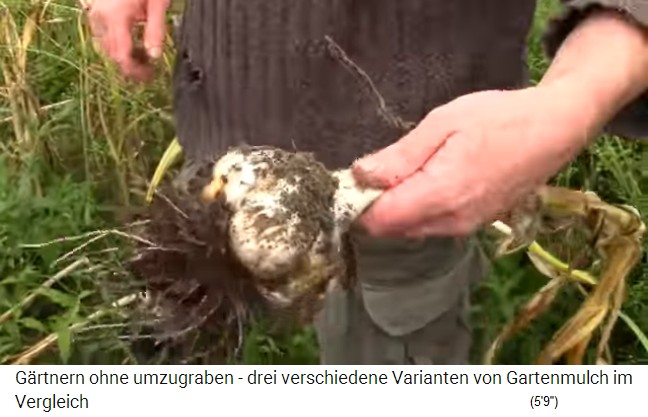

Planting bed with bark mulch [2]
Paths with red pine bark mulch [9]

Mulch film with holes on a garden bed [4]


Mulched tomatoes with straw mulch [24]
Homemade strawberries with straw mulch [25]

Herb garden with gravel [27]
Wood chips as path mulch [28]









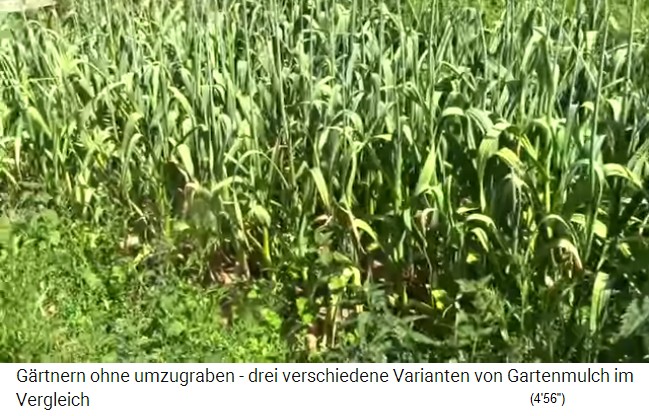
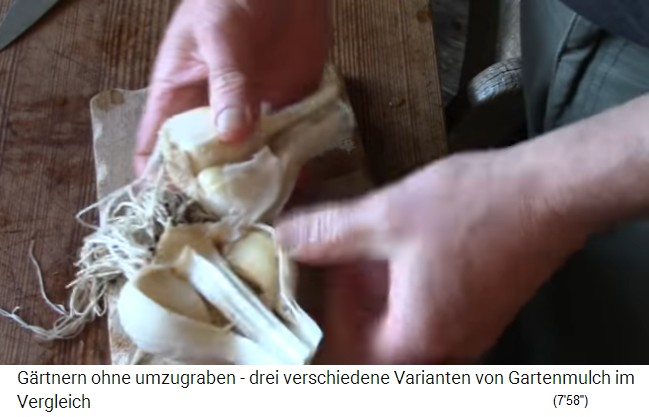



![The protective ring for the tree with pine cones
and large pebbles [14]: This is usually sufficient to
confuse dogs and cats so that they no longer urinate on
the tree trunk The protective ring for the tree
with pine cones and large pebbles [14]: This is usually
sufficient to confuse dogs and cats so that they no
longer urinate on the tree trunk](../d/004a02-mulchen-d/014-baumschutz-kiefernzapfen+steinring-gg-hunde+katzen-urinieren.jpg)



